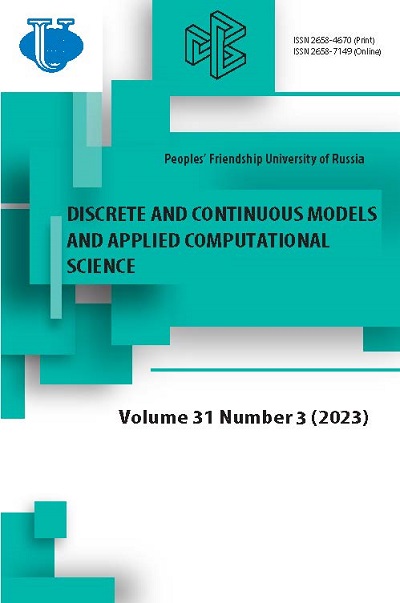On a stable calculation of the normal to a surface given approximately
- Authors: Laneev E.B.1, Baaj O.1
-
Affiliations:
- Peoples’ Friendship University of Russia (RUDN University)
- Issue: Vol 31, No 3 (2023)
- Pages: 228-241
- Section: Articles
- URL: https://journals.rudn.ru/miph/article/view/35919
- DOI: https://doi.org/10.22363/2658-4670-2023-31-3-228-241
- EDN: https://elibrary.ru/KNQAEY
- ID: 35919
Cite item
Full Text
Abstract
The paper proposes a stable method for constructing a normal to a surface given approximately. The normal is calculated as the gradient of the function in the surface equation. As is known, the problem of calculating the derivative is ill-posed. In the paper, an approach is adopted to solving this problem as to the problem of calculating the values of an unbounded operator. To construct its stable solution, the principle of minimum of the smoothing functional in Morozov’s formulation is used. The normal is obtained in the form of a Fourier series in the expansion in terms of eigenfunctions of the Laplace operator in a rectangle with boundary conditions of the second kind. The functional stabilizer uses the Laplacian, which makes it possible to obtain a normal in the form of a Fourier series that converges uniformly to the exact normal vector as the error in the surface definition tends to zero. The resulting approximate normal vector can be used to solve various problems of mathematical physics using surface integrals, normal derivatives, simple and double layer potentials.
Full Text
1. Introduction When solving many problems of mathematical physics, which are boundary value problems for partial differential equations, there is a need to calculate the normal to the surface, in particular, when calculating the normal derivative. For example, when calculating the potentials of a simple and double layer, as well as other surface integrals. In the case when the surface is known “exactly”, that is, for example, it is given by an equation with an exactly known functionAbout the authors
Evgeniy B. Laneev
Peoples’ Friendship University of Russia (RUDN University)
Email: elaneev@yandex.ru
ORCID iD: 0000-0002-4255-9393
Doctor of Physical and Mathematical Sciences, professor of Mathematical Department
6, Miklukho-Maklaya St., Moscow, 117198, Russian FederationObaida Baaj
Peoples’ Friendship University of Russia (RUDN University)
Author for correspondence.
Email: 1042175025@rudn.ru
ORCID iD: 0000-0003-4813-7981
Post-Graduate Student of Mathematical Department
6, Miklukho-Maklaya St., Moscow, 117198, Russian FederationReferences
- A. N. Tikhonov and V. J. Arsenin, Methods for solving ill-posed problems [Metody resheniya nekorrektnyh zadach]. Moscow: Nauka, 1979, in Russian.
- T. F. Dolgopolova and V. K. Ivanov, “On numerical differentiation,” USSR Computational Mathematics and Mathematical Physics, vol. 6, no. 3, pp. 223-232, 1966. doi: 10.1016/0041-5553(66)90145-5.
- V. V. Vasin, “The stable evaluation of a derivative in space C(-∞,∞),” USSR Computational Mathematics and Mathematical Physics, vol. 13, no. 6, pp. 16-24, 1973, english. doi: 10.1016/0041-5553(73)90002-5.
- R. S. Anderssen and P. Bloomfield, “Numerical differentiation procedures for non-exact data,” Numerische Mathematik, vol. 22, pp. 157-182, 1974. doi: 10.1007/BF01436965.
- C. W. Groetsch, “Optimal order of accuracy in Vasin’s method for differentiation of noisy functions,” Journal of Optimization Theory and Applications, vol. 74, pp. 373-378, 1992. doi: 10.1007/BF00940901.
- M. Hanke and O. Scherzer, “Inverse problems light: Numerical differentiation,” American Mathematical Monthly, vol. 108, no. 6, pp. 512-521, 2001, english. doi: 10.1080/00029890.2001.11919778.
- S. Ahn, U. J. Choi, and A. G. Ramm, “A scheme for stable numerical differentiation,” Journal of Computational and Applied Mathematics, vol. 186, no. 6, pp. 325-334, 2006, english. doi: 10.1016/j.cam.2005. 02.002.
- Z. Meng, Z. Zhao, D. Mei, and Y. Zhou, “Numerical differentiation for two-dimensional functions by a Fourier extension method,” Inverse Problems in Science and Engineering, vol. 28, no. 1, pp. 126-143, 2020, english. doi: 10.1080/17415977.2019.1661410.
- E. V. Semenova, S. G. Solodky, and S. A. Stasyuk, “Application of Fourier truncation method to numerical differentiation for bivariate functions,” Computational Methods in Applied Mathematics, vol. 22, no. 2, pp. 477-491, 2022, english. doi: 10.1515/cmam-2020-0138.
- V. A. Morozov, “On a stable method for computing the values of unbounded operators [Ob odnom ustoychivom metode vychisleniya znacheniy neogranichennykh operatorov],” Dokladi AN SSSR, vol. 185, no. 2, pp. 267-270, 1969, in Russian.
- E. B. Laneev and M. N. Muratov, “On the stable solution of a mixed boundary value problem for the Laplace equation with an approximately given boundary [Ob ustoychivom reshenii smeshannoy krayevoy zadachi dlya uravneniya Laplasa s priblizhenno zadannoy granitsey],” Vestnik RUDN. Matematika, vol. 9, no. 1, pp. 102-111, 2002, in Russian.
- E. B. Laneev, N. Y. Chernikova, and O. Baaj, “Application of the minimum principle of a Tikhonov smoothing functional in the problem of processing thermographic data,” Advances in Systems Science and Applications, no. 1, pp. 139-149, 2021. doi: 10.25728/assa.2021.21. 1.1055.
- O. Baaj, N. Y. Chernikova, and E. B. Laneev, “Correction of thermographic images based on the minimization method of Tikhonov functional,” Yugoslav Journal of Operations Research, vol. 32, no. 3, pp. 407-424, 2022. doi: 10.2298/YJOR211015026B.
- E. B. Laneev and E. Y. Ponomarenko, “On a linear inverse potential problem with approximate data on the potential field on an approximately given surface,” Eurasian mathematical journal, vol. 14, no. 1, pp. 57-70, 2023. doi: 10.32523/2077-9879-2023-14-1-55-70.
- R. W. Hamming, Numerical methods for scientists and engineers. New York: McGraw-Hill Book Company, 1962.
- E. B. Laneev and O. Baaj, “On a modification of the Hamming method for summing discrete Fourier series and its application to solve the problem of correction of thermographic images,” Discrete and Continuous Models and Applied Computational Science, vol. 30, no. 4, pp. 342-356, 2022. doi: 10.22363/2658-4670-2022-30-4-342-356.
- E. B. Laneev, M. N. Mouratov, and E. P. Zhidkov, “Discretization and its proof for numerical solution of a Cauchy problem for Laplace equation with inaccurately given Cauchy conditions on an inaccurately defined arbitrary surface,” Physics of Particles and Nuclei Letters, vol. 5, no. 3, pp. 164-167, 2002. doi: 10.1134/S1547477108030059.
Supplementary files















